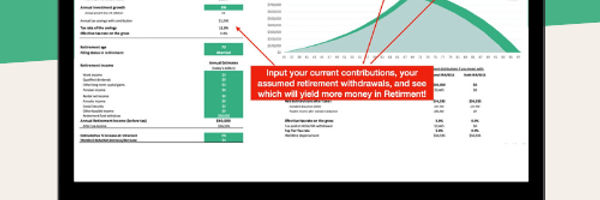This article is going to cover the topic of IRA withdrawals. Here we're going to summarize the withdrawal or distribution rules that apply to a Traditional, Roth, and SIMPLE IRAs. We're going to talk about qualifying and minimum required distributions, exceptions to these rules, and possible income tax penalties. In the following sections, we're going to use the words distribution and withdrawal interchangeably. For the most part, IRA holders believe they are making withdrawals from their account, while in the "technical" sense, the IRS considers these distributions.

Roth IRA or 401k? This template will answer your questions.
With this template, you will get:
All DFY, simply add your details
Charts for comparison and clear answer
Easily update for any year (2023, 2024, 2025, etc…)

Traditional IRA Withdrawal Rules
All withdrawals from a Traditional IRA before age 59 1/2 are considered early withdrawals. If an accountholder takes an early withdrawal from their Traditional IRA, then in addition to any regular federal income or state income tax due, they also need to pay an additional 10% tax penalty.
Minimum Required Distributions or MRD
Traditional IRAs also have a minimum required distribution rule. The MRD begins when the holder of a Traditional IRA reaches age 70 1/2. The intention of this withdrawal rule is to make sure that retirement money sitting in a Traditional IRA is methodically removed from that account (and taxes are paid) over the remaining expected lifespan of the accountholder. The specific MRD rules include:
Individuals must start receiving minimum distributions from their Traditional IRA by April 1st of the year following the year they reach age 70 1/2. This is referred to as the beginning date.
Starting with the beginning date, individuals must receive at least the minimum required amount each year. If an individual does not withdraw that minimum in the year they turned 70 1/2, then they must receive a minimum distribution for their 70 1/2 year by April 1st of the following year.
The minimum required distribution for any year after the year an individual turns 701/2 must be made by December 31st of that later year.
Even if an individual receives more than the required distribution in any year, they don't take a "credit" on their remaining account balance when calculating their MDR in future years.Moneyzine Editor
Remember, the intention here is to disburse the money over someone's expected remaining lifespan. So even if someone starts receiving distributions from their IRA before age 70 1/2, they still need to start calculating their required MRD by the beginning date mentioned earlier. Even if an individual receives more than the required distribution in any year, they don't take a "credit" on their remaining account balance when calculating their MDR in future years.
Early Withdrawal Exceptions
Previously, we mentioned there were exceptions to the age 59 1/2 rule. In reality everyone that owns an IRA can take a withdrawal before the age 59 1/2 and avoid the 10% tax penalty. Everyone qualifies for penalty-free IRA withdrawals provided they take the money out in a certain fashion or for a certain reason. Let's take a closer look at how that can happen. There are a total of eight exceptions to the age 59 1/2 rule that are outlined by the IRS:
Unreimbursed Medical Expenses: If medical expenses are more than 7.5% of an individual's adjusted gross income for that year, then they are allowed to take an IRA withdrawal without paying the 10% tax penalty.
Medical Insurance: If an individual lost their job, received unemployment compensation, and paid for medical insurance for them, their wife and their dependents, they might be able to withdraw from their IRA in the amount they paid for the insurance; provided they did not receive the distribution more than 60 days after finding a job.
Disability: If a physician determines an individual is unable to do any substantial gainful activity due to physical or mental conditions, then they can make withdrawals that are not subject to the 10% tax penalty.
Beneficiary of an IRA: If an individual dies before reaching age 59 1/2, then their IRA can be distributed to their beneficiaries or estate penalty free.
Higher Education Expenses: Individuals that paid expenses for higher education during the year, part (or all) of any distribution may not be subject to the 10% tax penalty.
First Time Homeowner: Early withdrawals from an IRA can be made if the money is used to purchase, rebuild, or build a first home. The distributions are limited to $10,000, and must be withdrawn no more than 120 days after making the purchase.
Rollover into another Qualified Plan: If the withdrawal is rolled over into another qualifying IRA or plan in a timely manner, then it is not subject to the 10% early withdrawal penalty.
This next rule is an interesting one. The federal government does not want to deny anyone access to their retirement money, as long as the money was truly going to be used for retirement. This is the basis for this final IRS withdrawal rule:
Annuity Distributions: Withdrawals can be made from a Traditional IRA that is part of a series of substantially equal amounts that will occur over a lifetime. An IRS approved method must be used to calculate these withdrawals. These equal payments must continue for at least 5 years or until age 59 1/2, whichever is later. That means if these payments start at age 57, they must remain the same until age 62. A one-time adjustment can be made to the amount withdrawn.
With any of these eight exceptions, it is best to seek the advice of a qualified tax professional. An IRA account is intended to provide income in retirement. If at all possible, it should be kept safe for that purpose.

Roth IRA or 401k? This template will answer your questions.
With this template, you will get:
All DFY, simply add your details
Charts for comparison and clear answer
Easily update for any year (2023, 2024, 2025, etc…)

Roth IRA Withdrawal Rules
In general, individuals can take a distribution from their Roth IRA once they've reached age 59 1/2 and after the 5-taxable-year period (which starts with the first year they made a contribution to a Roth IRA) has passed. Unlike a Traditional IRA, individuals are not required to take a minimum required distribution from a Roth. If a withdrawal is not considered a qualified distribution, then the money may be taxed as ordinary income and subject to the additional 10% early withdrawal penalty. Even if a contribution had been included in taxable income in earlier years, a distribution before the 5-taxable-year period expires on a Roth conversion may be subject to this 10% penalty.
Roth IRA Early Withdrawal Exceptions
Just like the Traditional IRA, there are three exceptions to the early withdrawal rules that apply to a Roth.
Beneficiary of an IRA: If the accountholder dies before reaching age 59 1/2, then their Roth IRA can be distributed to their beneficiaries or estate penalty free.
Disability: If a physician determines an individual is unable to do any substantial gainful activity due to physical or mental conditions, then they can make withdrawals that are not subject to the 10% penalty.
First Time Homeowner: Accountholders can make an early withdrawal from a Roth IRA if they use the money to purchase, rebuild, or build their first home. Qualified costs include the main home of a first time home buyer, their spouse, children, grandchildren, a parent, or another ancestor.
SIMPLE IRA Withdrawal Rules
In general, an employer cannot require an employee to keep any portion of their contributions in their SIMPLE IRA. Employers are also not allowed to introduce any plan-specific withdrawal rules.
Withdrawal Exceptions
SIMPLE IRAs follow the same withdrawal rules that apply to Traditional IRAs, including exceptions. But there is also a "2-year period" rule that is unique to SIMPLE IRAs. The 2-year period begins on the date on which the employee first participated in any SIMPLE IRA plan maintained by their employer. If an employee takes an early distribution within this 2-year period, then the additional tax penalty is raised from 10% to 25%. However, if one of the exceptions mentioned earlier applies to these early withdrawals, then the 25% tax penalty is not imposed.


